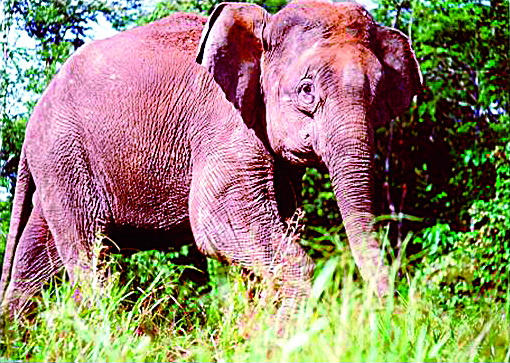|
| Query: loxodonta pumilio | Result: 2nd of 2 | |
Pygmy Elephant (Family: Elephantidae) - Wiki
| Subject: | Pygmy Elephant (Family: Elephantidae) - Wiki
| |

| Resolution: 510x363
File Size: 159627 Bytes
Date: 2007:09:06 21:20:36
Upload Date: 2007:09:06 21:25:53
|
Pygmy elephant
From Wikipedia, the free encyclopedia
[Photo] The Borneo pygmy elephant Elephas maximus borneensis. Borneo Elephant
Source (2003) Borneo Elephants: A High Priority for Conservation. PLoS Biol 1(1): e7. Date 2003. Author PLoS Biology
Pygmy Elephants are cryptids, reported to be living in both Africa and Asia. The African Pygmy Elephant, described as Loxodonta pumilio, is currently considered to be a tiny morph of the African Forest Elephants (L. cyclotis); see Debruyne et al. (2003).
The Borneo Elephant (Elephas maximus borneensis) is also called "Pygmy Elephant." This elephant, inhabiting tropical rainforest in north Borneo (east Sabah and extreme north Kalimantan), was long thought to be identical to the Asian Elephant and descended from a captive population. In 2003, DNA comparison revealed them to be probably a new subspecies. There are believed to be fewer than 1,500 left, although no population study has ever been done. The World Wide Fund for Nature is planning such a study in 2007.
The term Pygmy Elephant should not be confused with "dwarf elephant" which is used for a number of extinct species of elephants that evolved their size due to island dwarfing.
Pygmy elephants of India
Kani tribals dwelling in the rain forests of the Western Ghats, (Kerala, India) claim that there are two distinct varieties of elephants in the Peppara forest range (part of Western Ghat), one the common Indian elephants and the other a dwarf variety which they call "Kallana". The existence of a pygmy variety of elephant in India is yet to be scientifically ascertained.
The name "Kallana" comes from the words "Kallu", which means stones or boulders, and "aana", which means elephant. The tribals gave the creatures this name because they see the smaller elephant more often in the higher altitudes where the terrain is rocky. Some tribals also call the delicate creatures "Thumbiaana", thumbi meaning dragonfly, for the speed with which the elephants run through trees and rocks when disturbed.
If the claims of Kani tribals are believed, there are ample reasons to believe that the Kallaana they describe is a different pygmy variety of elephant since it is claimed to grow a maximum height of about 1.5 meters (5 feet), and do not interbreed with the more common Indian elephants, even taking pains to avoid them. In all other respects, they look like Indian elephants. According to the Kani tribals, pygmy elephants feed on grass, bamboo leaves, tubers and the barks of smaller trees. Like all elephants, they enjoy bathing in rivers and they too have dust baths. Unlike larger elephants, however, they seem able to negotiate steep, rocky inclines. For the past 15 years the forest officials and inhabitants of Agasthyamala regions have heard Kani tribals talking about their Kallaanas. However, there were never any confirmed sightings.
Recently Sali Palode, a Kerala-based wildlife photographer and Mallan Kani, a member of Kerala’s Kani tribe who were in search of this elusive elephant could fortunately photograph one such dwarf elephant, and claim to have even seen a herd. Some experts, of course, continue to dispute the claims and vociferously maintain that these are baby elephants. Only DNA tests can establish the truth. The efforts of Sali Palode and the Mallan Kani will herald a new vigour to ascertain the truth, by detailed reasearch. The Kerala Forest Department has recently deputed search teams to the forests of Agasthyavanam, Neyyar and the Peppara Wildlife Sanctuary to search for the pygmy elephants.
http://en.wikipedia.org/wiki/Pygmy_elephant
| The text in this page is based on the copyrighted Wikipedia article shown in above URL. It is used under the GNU Free Documentation License. You may redistribute it, verbatim or modified, providing that you comply with the terms of the GFDL. |
|
Comments |
|---|
| | Guest |
|
| jjjjjjjjjjjjjjjjjjjjjjjjjjjjjjjjjjjjjjjjjjjjjjjjjjjjjjjjjjjjjjjjjjjjjjjjjjjjj |
^o^
Animal Pictures Archive for smart phones
^o^
|
|
|

